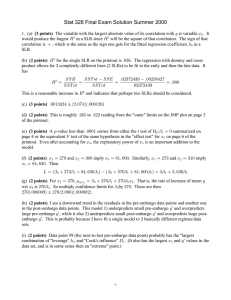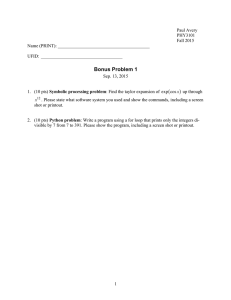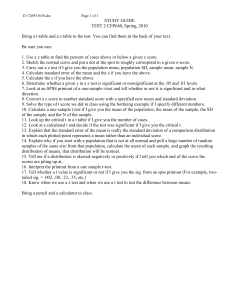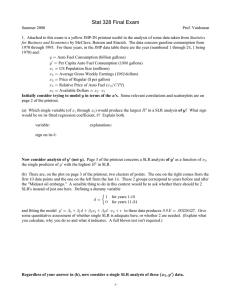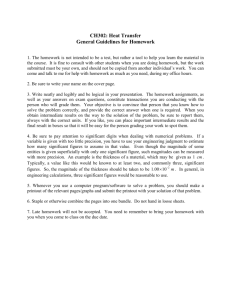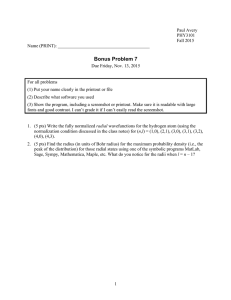Stat 328 MidTerm Summer 2000 Prof. Vardeman
advertisement
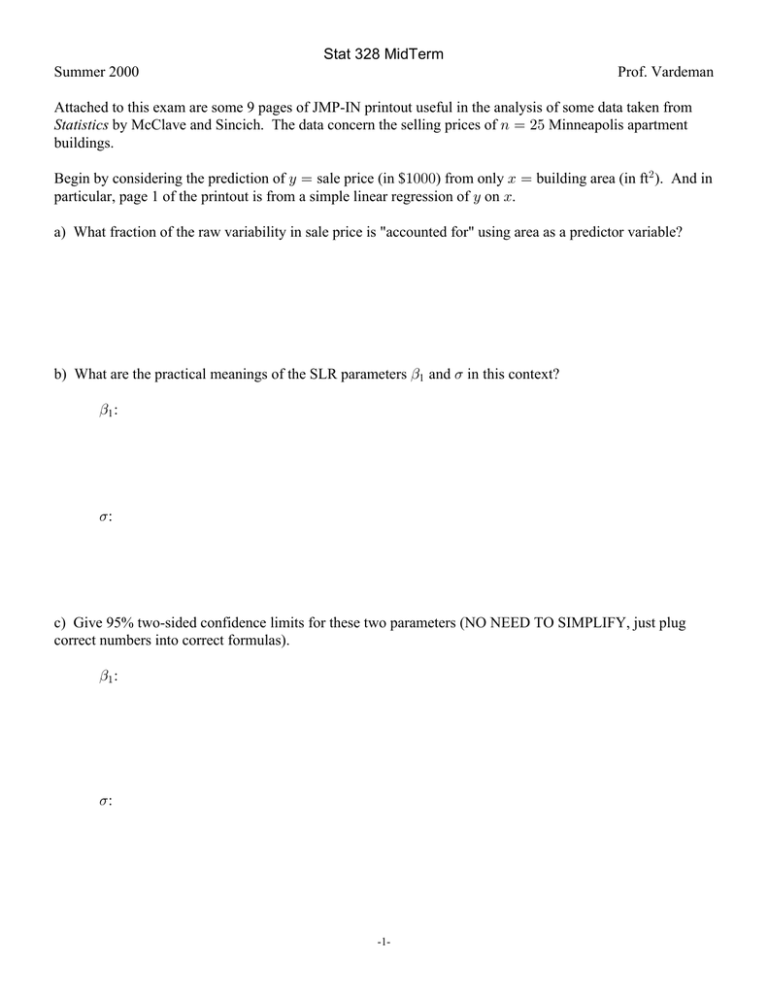
Stat 328 MidTerm Summer 2000 Prof. Vardeman Attached to this exam are some 9 pages of JMP-IN printout useful in the analysis of some data taken from Statistics by McClave and Sincich. The data concern the selling prices of 8 œ #& Minneapolis apartment buildings. Begin by considering the prediction of C œ sale price (in $"!!!) from only B œ building area (in ft# ). And in particular, page 1 of the printout is from a simple linear regression of C on B. a) What fraction of the raw variability in sale price is "accounted for" using area as a predictor variable? b) What are the practical meanings of the SLR parameters "1 and 5 in this context? "1 : 5: c) Give 95% two-sided confidence limits for these two parameters (NO NEED TO SIMPLIFY, just plug correct numbers into correct formulas). "" : 5: -1- d) Give 95% two-sided confidence limits for the mean sales price of a "!ß !!! ft# apartment building in Minneapolis at the time of this study. (The sample mean of B is B œ ""ß %#$Þ% and the sample standard deviation of B is =B œ "!ß !"*Þ%.) Show some work, but after plugging into a formula, NO NEED TO SIMPLIFY. e) A Minneapolis landlord gets a property tax notice that places the valuation of an apartment building (that is supposed to be based on fair market value) at $*!!ß !!!. This building is of size $&ß !!! ft# . The landlord wants to challenge the valuation. Based on the information on page 1 of the printout, does the landlord have a case? EXPLAIN. (More is required here than simply noting that sC is less than $*!!ß !!!. BUT YOU NEED NOT SHOW ANY CALCULATIONS.) f) Temporarily suppose that the estimated parameter values from the SLR are exactly equal to the (actually unknown) parameter values. (This is too much to hope for, but humor me here.) Under this possibility, what fraction of sales of #!ß !!! ft# Minneapolis apartment buildings would be for more than $&!!ß !!!? -2- g) What about the plot on page 1 of the printout causes some concern that the SLR model relating C to B may not be a completely appropriate one? Page 2 of the printout shows a plot of ÈC versus ÈB and the associated least squares line. Why does or does not this 2nd plot look "better" in terms of appropriateness of the standard SLR model? Comments about page 1: Comments about page 2: h) A SLR analysis of ÐÈBß ÈC Ñ pairs "transforms back" to the original scales (through squaring) to produce the report on page 3 of the printout. Consider again the issue raised in part e). Would your answer be different based on this 2nd analysis? Explain. There was, in fact, more information available on the #& buildings than simply their sizes and sales prices. The numbers of apartments in the buildings, the building ages (in years, according to McClave and Sincich), and the numbers of off-street parking spots were also available. The complete data set is on page 4 of the printout. Pages 5-9 of the printout are concerned with a regression of sales price on the other 5 œ % variables. (No guarantee that this is a good model ... just the one we'll use here.) i) The MLR estimate of "5" is smaller than the SLR estimate of "5". Explain the difference in the two meanings of "5" and why you are not surprised about the reduction in "=". -3- j) What fraction of the raw variability in sales price is "accounted for" using all % predictor variables? If you wanted to attach a :-value this (or equivalently determine if these % predictors provide a "statistically significant" ability to predict sales price) where on the prinout would you get such a :-value, and what is it? fraction accounted for: :-value and origin: k) After accounting for building size, do the other $ predictors "add significantly to one's ability to predict C"? Compute an appropriate J statistic, give the degrees of freedom and say what the J tables in the book reveal about the associated :-value. J œ __________ d.f. œ __________ :-value: l) Suppose the current Minneapolis formula for making real estate valuations adds $&ß !!! per off-street parking place to an apartment buildings' assessed valuation. What does this MLR analysis have to say about that part of the Minneapolis formula? -4- m) The largest (in absolute value) residual here is associated with building #25. Interestingly enough, the SLR formula on page 1 of the printout does a much better job of predicting its selling price. Looking at the predictor values for the case, what "explanation" can you offer for the large MLR residual? n) What are 95% two-sided prediction limits for the selling price of a building with characteristics like that of building #25? (NO NEED TO SIMPLIFY.) o) Look at the "prediction profile" part of the JMP report. Note that while these plots are set up around the values of predictors for building #12, they would just be shifted up or down (and not changed in fundamental character) by changing this point to some other values. At least across this data set, which predictor variable seems to have the largest impact on selling price? Explain. -5- sale price By building area 1000 800 600 400 200 0 0 5000 10000 15000 20000 25000 building area 30000 Linear Fit Linear Fit sale price = 57.0937 + 0.02044 building area Summary of Fit 0.93723 RSquare RSquare Adj 0.934501 Root Mean Square Error 54.13609 Mean of Response 290.5735 25 Observations (or Sum Wgts) Analysis of Variance Source Model DF Sum of Squares Mean Square F Ratio 1 1006463.5 1006463 343.4189 Error 23 67406.5 2931 Prob>F C Total 24 1073869.9 <.0001 Parameter Estimates Term Estimate Std Error t Ratio Prob>|t| Intercept 57.093707 16.61217 3.44 0.0022 building area 0.0204387 0.001103 18.53 <.0001 1 35000 40000 root(price) By root(area) 35 30 25 20 15 10 5 50 75 100 125 root(area) 150 Linear Fit Linear Fit root(price) = 2.89891 + 0.13344 root(area) Summary of Fit Analysis of Variance Parameter Estimates 2 175 200 sale price By building area 1000 800 600 400 200 0 0 5000 10000 15000 20000 25000 building area 30000 Transformed Fit Sqrt to Sqrt Transformed Fit Sqrt to Sqrt Sqrt(sale price) = 2.89891 + 0.13344 Sqrt(building area) Summary of Fit Analysis of Variance Parameter Estimates Fit Measured on Original Scale Sum of Squared Error 65352.659 Root Mean Square Error 53.304971 R-square 0.9391429 Sum of Residuals 51.720223 3 35000 40000 Mnsales Rows 1 2 3 4 5 6 7 8 9 10 11 12 13 14 15 16 17 18 19 20 21 22 23 24 25 number of apartments 4 20 5 26 5 10 4 11 20 62 26 13 9 6 11 5 20 4 8 4 4 4 14 4 5 age 82 13 66 64 55 65 82 23 18 71 74 56 76 21 24 19 62 70 19 57 82 50 10 82 82 parking spaces 0 0 0 6 0 0 0 0 20 3 0 13 0 6 8 5 2 0 0 0 0 0 0 0 0 4 building area 4266 14391 6615 34144 6120 14552 3040 7881 12600 39448 30000 8088 11315 4461 9000 3828 13680 4680 7392 6030 3840 3092 23704 3876 9542 sale price 90.3 384 157.5 676.2 165 300 108.75 276.538 420 950 560 268 290 173.2 323.65 162.5 353.5 134.4 187 155.7 93.6 110 573.2 79.3 272 Response: sale price Summary of Fit RSquare 0.980361 RSquare Adj 0.976434 Root Mean Square Error 32.47245 Mean of Response 290.5735 Observations (or Sum Wgts) 25 Parameter Estimates Estimate Std Error t Ratio Prob>|t| Intercept 99.966826 18.66129 5.36 <.0001 number of apart 4.4441508 1.156072 3.84 0.0010 age -0.886493 0.275437 -3.22 0.0043 parking spaces 2.6059525 1.518891 1.72 0.1017 building area 0.0154868 0.00142 10.91 <.0001 Term Effect Test Source Nparm DF Sum of Squares F Ratio Prob>F number of apart 1 1 15582.53 14.7777 0.0010 age 1 1 10922.83 10.3587 0.0043 parking spaces 1 1 3103.92 2.9436 0.1017 building area 1 1 125506.63 119.0246 <.0001 5 Whole-Model Test number of apart 1000 800 600 400 200 0 0 200 400 600 sale price Predicted 800 1000 Analysis of Variance Source DF Sum of Squares 4 1052780.7 Error 20 21089.2 C Total 24 1073869.9 Model Mean Square F Ratio 263195 249.6019 1054 Prob>F <.0001 75 50 25 residual 0 -25 -50 -75 0 200 400 600 sale price Predicted 800 1000 6 age parking spaces building area Screening Fit sale price Summary of Fit Analysis of Variance Parameter Estimates Effect Test Prediction Profile 900 267.108 100 4 13 62 number of apartments 10 56 82 age 0 13 parking spaces 7 20 3040 8080 39448 building area Contour Profiler Horiz Vert Factor Grid Density Current X number of apartments 13 age 56 parking spaces 13 building area 20 x 20 Update Mode Immediate 8080 Response Contour Current Y Lo Limit Hi Limit sale price 500 267.108 ? 500 62 sale price number of apartments number of apartments 0 building area sale price 4 3040 building area 39448 8 Mnsales Rows 1 2 3 4 5 6 7 8 9 10 11 12 13 14 15 16 17 18 19 20 21 22 23 24 25 Predicted sale price 111.1178 400.1961 166.1243 703.1965 168.2098 312.1504 92.13093 250.5147 420.1458 931.3047 614.5186 267.2319 247.824 192.7378 287.8056 177.6575 350.9587 128.1672 233.1552 160.5988 104.5204 121.304 520.4193 105.0779 197.2703 StdErr Pred sale price 11.05292 16.16856 8.34342 22.26557 8.034507 9.58784 11.59105 12.93596 24.40365 29.84458 16.35477 17.19549 9.257175 11.56224 11.23431 11.88533 9.502139 9.186342 13.13862 8.176873 11.21224 9.43203 21.18746 11.1976 11.21527 9
